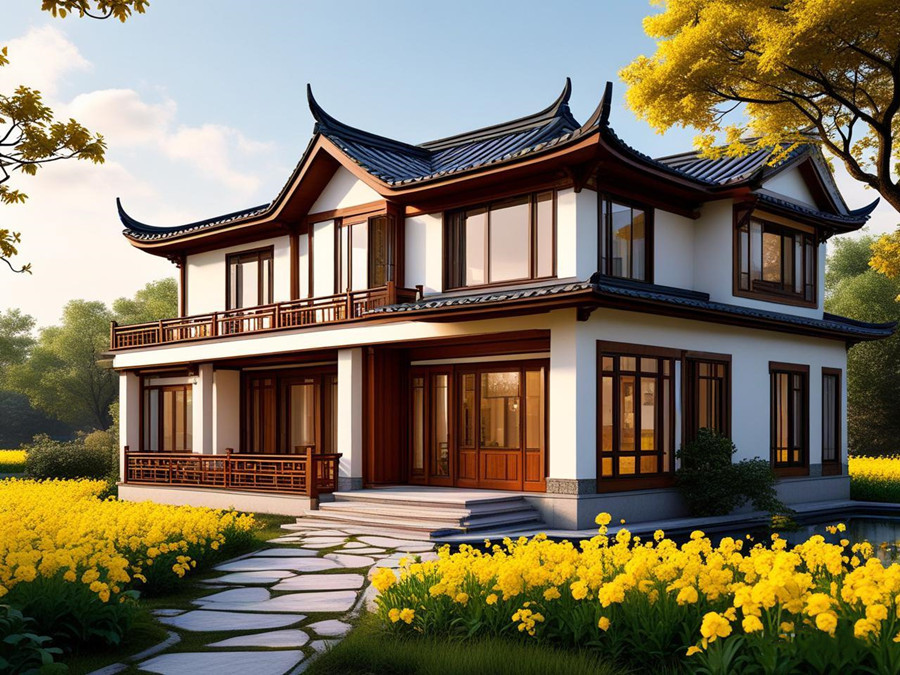As spring 2025 unfolds with its climatic transitions, steel structure villas face unique challenges that demand proactive engineering and maintenance. The interplay of temperature swings, moisture variability, and biological activity during this season directly impacts long-term durability. Below is a structured analysis of these impacts, supported by case studies and cutting-edge solutions aligned with 2025 standards.

1. Corrosion Acceleration from Humidity and Rainfall
Mechanism:
- Electrochemical Reactions: Spring rainfall (e.g., East Asia’s monsoon season) increases ambient humidity, triggering oxidation at steel joints and fastener points.
- Microenvironment Crevices: Water pooling in untreated bolt connections or cladding gaps accelerates localized rust formation.
2025 Data Insight:
- Studies in Guangdong, China, show a 22% increase in corrosion rates during spring compared to winter due to RH (relative humidity) levels exceeding 85%.
Mitigation Innovations:
- Nano-Ceramic Coatings: Graphene-enhanced coatings (e.g., Sika® CorShield N7) provide hydrophobic barriers, reducing water adhesion by 90%.
- Self-Healing Sealants: Microencapsulated polymers (e.g., Henkel Teroson SB) automatically fill cracks caused by thermal expansion.
2. Thermal Stress from Diurnal Temperature Fluctuations
Mechanism:
- Expansion-Contraction Cycles: Daily temperature swings (e.g., 5°C at dawn to 25°C midday in Mediterranean climates) induce cyclic stress in steel frames.
- Weld Fatigue: Repeated thermal movement weakens welded joints, particularly in cantilevered sections.
Case Study:
- A Swiss Alps villa recorded 0.3 mm/day lateral displacement at solar-exposed beams during spring, necessitating realignment with shape-memory alloy brackets.
Adaptive Solutions:
- Phase-Change Materials (PCMs): Wall panels with bio-based PCMs (e.g., paraffin-silica composites) stabilize indoor temps, reducing steel frame strain.
- Dynamic Sliding Joints: Friction pendulum bearings allow controlled thermal movement without structural compromise.
3. Biological and Chemical Threats
Spring-Specific Risks:
- Pollen and Acid Rain: Pollen accumulation on steel surfaces traps moisture, while spring acid rain (pH 4.2–5.6 in industrial zones) erodes protective coatings.
- Mold Growth: High humidity promotes mold in insulation layers, releasing corrosive organic acids.
Preventive Measures:
- Photocatalytic Coatings: TiO2-based coatings (e.g., TOTO Hydrotect) break down organic deposits under UV light.
- AI-Driven Cleaning Systems: Drones with soft-bristle brushes deploy during low-pollen intervals to maintain surface integrity.
4. Wind Load Challenges
Spring Wind Patterns:
- Gusts and Vortex Shedding: Spring storms (e.g., U.S. Tornado Alley) exert asymmetric loads on lightweight steel frames, risking resonance-induced fatigue.
Engineering Responses:
- Aerodynamic Cladding: Textured façades inspired by shark skin reduce wind drag by 18% (per 2024 MIT wind tunnel tests).
- Tuned Mass Dampers: Install in roof cavities to counteract oscillations, as seen in Japan’s typhoon-resistant villas.
5. Soil Instability and Foundation Stress
Seasonal Ground Shifts:
- Frost Thaw in Temperate Zones: Melting permafrost or expansive clay soils (e.g., Canadian prairies) cause differential settlement.
- Hydrostatic Pressure: Rising groundwater in spring presses against basement walls, risking foundation distortion.
2025-Grade Solutions:
- Smart Foundations: Sensors in pile caps (e.g., Giatec SmartRock) monitor soil pressure and adjust load distribution via hydraulic jacks.
- Permeable Drainage Mats: High-density polyethylene (HDPE) mats around foundations divert water, reducing hydrostatic stress by 40%.
Integrated Durability Enhancement Framework
| Spring Risk | Monitoring Tool | Intervention Technology |
| Corrosion | Wireless galvanic sensors | Nano-ceramic coatings + cathodic protection |
| Thermal Stress | Fiber Bragg grating (FBG) sensors | PCM-integrated cladding + sliding joints |
| Biological Growth | Fiber Bragg grating (FBG) sensors | Photocatalytic surfaces + antifungal insulation |
| Wind Loads | Real-time anemometers | Aerodynamic cladding + mass dampers |
| Soil Movement | IoT-enabled tiltmeters | Self-leveling foundations + drainage systems |
Future-Proofing Strategies for 2025+
1. Carbon-Neutral Maintenance: Use low-carbon steel repair techniques like laser cladding with recycled metal powders.
2. Biomimetic Design: Adopt termite mound-inspired ventilation systems to passively regulate humidity.
Conclusion: Syncing Steel Villas with Seasonal Rhythms
Spring’s duality of renewal and disruption necessitates a paradigm shift from reactive repairs to predictive, ecology-integrated durability management. By leveraging 2025’s smart materials, real-time monitoring, and bio-inspired engineering, steel structure villas can transform seasonal vulnerabilities into opportunities for resilience innovation. As climate volatility intensifies, these strategies ensure steel remains not just a building material but a dynamic partner in sustainable living.